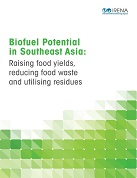Biofuel potential in Southeast Asia: Raising food yields, reducing food waste and utilising residues
 Southeast Asia has considerable resources to produce liquid biofuels sustainably, using biomass feedstocks that would not cause carbon-dioxide emissions or interfere with food supply. Fulfilling the region’s biofuel potential would depend on increased residue collection from food crops and forest products, intensified cultivation of farmland, and reducing waste and losses in the food chain. Biofuel potential in Southeast Asia offers detailed estimates of biomass resource potential for Indonesia, Malaysia, the Philippines, Thailand and Viet Nam. All five countries belong to both the Association of Southeast Asian Nations (ASEAN) and Asia Pacific Economic Cooperation (APEC). With conversion to advanced liquid biofuels, sustainable biomass feedstock could potentially cover two-fifths of the region’s projected needs for transport fuel if less were diverted to residential heating and cooking. According an assessment by the bioenergy team at the International Renewable Energy Agency (IRENA), advanced biofuels could provide as much as 7.3 exajoules of primary energy per annum in Southeast Asia by 2050, or half of the region’s total primary bioenergy potential.
Southeast Asia has considerable resources to produce liquid biofuels sustainably, using biomass feedstocks that would not cause carbon-dioxide emissions or interfere with food supply. Fulfilling the region’s biofuel potential would depend on increased residue collection from food crops and forest products, intensified cultivation of farmland, and reducing waste and losses in the food chain. Biofuel potential in Southeast Asia offers detailed estimates of biomass resource potential for Indonesia, Malaysia, the Philippines, Thailand and Viet Nam. All five countries belong to both the Association of Southeast Asian Nations (ASEAN) and Asia Pacific Economic Cooperation (APEC). With conversion to advanced liquid biofuels, sustainable biomass feedstock could potentially cover two-fifths of the region’s projected needs for transport fuel if less were diverted to residential heating and cooking. According an assessment by the bioenergy team at the International Renewable Energy Agency (IRENA), advanced biofuels could provide as much as 7.3 exajoules of primary energy per annum in Southeast Asia by 2050, or half of the region’s total primary bioenergy potential.
